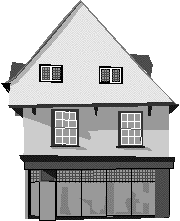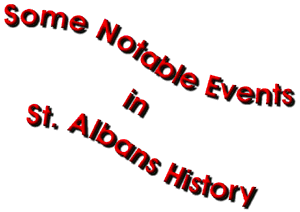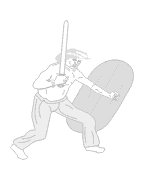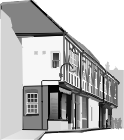|

|
- End of First Century B.C.. - A large
settlement of the Celtic Catuvellauni developed and was
known as Verlamion. Coins of
Tasciovanus and Cunobelin were minted here.
- A.D.50 The Roman City of Verulamium
founded.
- 60 Verulamium destroyed by Queen Boudicca
(Boadicea).
- 79 The Forum and Basilica opened.
- 155 Much of Verulamium destroyed by
fire.
- Third Century. Alban a citizen of Verulamium
martyred for his Christian faith.
- c. 275 City wall built enclosing 80
hectares.
- c. 450 By this date the Roman City had almost
ceased to exist.
- 730 The historian Bede recorded that a "
beautiful church worthy of his (Albans) martyrdom was
built, where sick people are healed and frequent miracles
take place to this day". At this time
St.Albans/Verulamium was known as Watlingchester or
Verulamchester. Originally Watling Street was the name
given to the road from London to St. Albans.
- 793 St. Albans Abbey "founded" by King Offa of
Mercia. Eventually the town of St, Albans grew up around
the Abbey.
- 1077 Paul of Caen, the first Norman Abbot
began rebuilding the Abbey.
- 1086 At the time of Domesday Book about 500
people lived in the town.
- 1142 During his troubled reign King Stephen
sent men to arrest the Earl of Arundel who was unhorsed
and nearly drowned at Holywell Bridge.
- 1213 Council held at the Abbey at which Barons
and Churchmen first discussed their grievances - this was
the first step towards the Magna Carta of 1215.
- 1217 After Magna Carta was ignored by the
King, the barons invited French help to depose John. The
Dauphin of France occupied the town in 1217. A month
later the army of the new young King 600 III led by the
notorious Faulkes de Breaute sacked the town. A few
months later the Dauphin returned to despoil the
town.
- 1324 Abbey broken into by the townsmen in an
attempt to deprive the Abbot of those charters by which
he claimed superiority over them.
- 1327 More serious trouble; the townsmen laid
siege to the Abbey in pursuit of their claims to greater
independence.
- 1349 The Black Death caused many deaths in the
town and Abbey.
- 1381 The Great or Peasants Revolt gave the
townsmen an opportunity to press their claims again. The
abbots warrens and woods were broken into, four houses
destroyed and the Abbot"s prison broken open. In the
retribution that followed 17 men were hanged and many of
the leading townsmen imprisoned. John Ball one of the
national leaders of the rebels was brought from Coventry
and tried in front of the King, in the Moot Hall. He was
condemned to drawing,(on a hurdle),hanging, beheading,
disembowelling and quartering!
- 1455 The First
Battle of St. Albans opened the War of the Roses. The
Lancastrian army led by King Henry VI occupied the town
but the Yorkist forces of the Duke of Warwick managed to
break in and a battle took place in the town centre. King
Henry was wounded by an arrow and captured.
- 1461 The Second Battle
of St. Albans led to victory for the Lancastrians
under Queen Margaret who brought her forces down Watling
Street from Dunstable. Much of the fighting took place on
Bernards Heath on the north of the town and the Yorkists
in retreat left the King (who had been released from his
first captivity at St. Albans and then retaken) sitting
under an oak tree on Nomansland common.
- 1539 The Abbey was dissolved on Dec. 5th by
King Henry VIII.
- 1553 King Edward VI granted a charter to the
town by which it became a Borough with a Mayor and
Corporation. The King sold the Abbey Church to the town
for £400
- 1555 George Tankerfield, a protestant
Yorkshire baker was brought from London and burnt to
death on Romeland - as an example to others.
- 1643 The High Sheriff of Hertfordshire was
arrested by Captain Oliver Cromwell after he had unwisely
read a Royal Proclamation, from the steps of the Eleanor
Cross. Later that year the town was the headquarters of
the Earl of Essex's Parliamentary Army.
- 1645 The New Model Army was reviewed by
Fairfax at St. Albans.
- 1648 An Army Council was held in the Abbey
Church which effectively sealed the fate of King Charles
I.
- 1852 The town deprived of representation in
Parliament because of bribery and corruption at
elections.
- 1877 The Abbey Church was granted Cathedral
status and the town a City charter.
|




